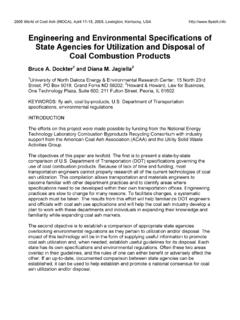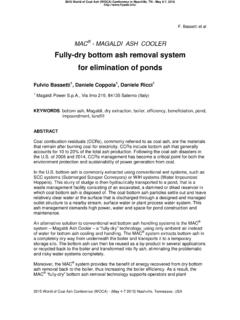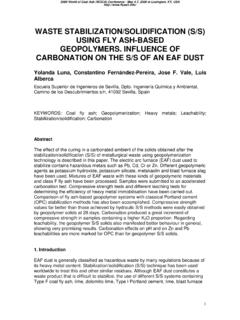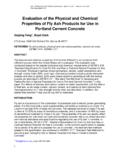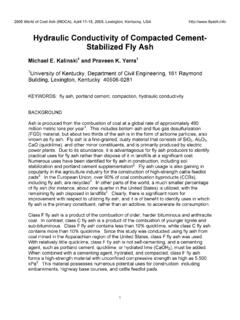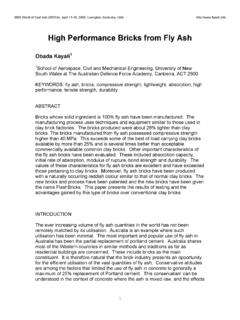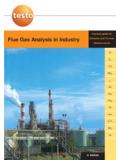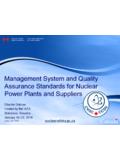Transcription of C oal C ombustion P roducts: a Global P erspective
1 Coal Combustion Products: a Global Perspective Craig Heidrich1, Hans-Joachim Feuerborn2, Anne Weir3 1 Ash Development Association Australia, PO BOX 1194, Wollongong NSW 2500 AUSTRALIA, Email 2 European Coal Combustion Products Association, Klinkestrasse 27-31, 45136 Essen/GERMANY, Email ; 3 Canadian Industries Recycling Coal Ash (CIRCA), 301 Oxford Street, W. PO #24159 Cherry Hill London, ON N6H 5C4 CANADA, Email KEYWORDS: coal combustion products (CCPs), fly ash, bottom ash, Global production and utilization, harmonized system, legislation ABSTRACT Whenever coal is burnt, coal combustion products are produced by the thermal transformation of the mineral matter present into amorphous inorganic oxides.
2 Large-scale use of coal in power generation gives rise to significant quantities of coal combustion products from which important hard won end use markets have been established. Existing and proposed end use markets for coal combustion products (CCPs) are not only of critical importance to the economics of power generation, but also to the established supply chain participants which have invested, researched, developed and promoted CCPs into various end use markets, for example the construction sector use large quantities.
3 Globally, the continued growth in utilization of CCPs is dependent on many factors beyond the quality and characteristics. Appropriate legislation and regulation coupled with the development of international classification systems, standards and codes of practice are only a few of the important enablers for easing the way towards increasing utilization and securing the legal certainly for continued investment. The paper provides a Global perspective on the role of coal in worldwide energy production and changing paradigms in the energy mix.
4 Current Global CCP production and utilization including volume and value of international trade will be discussed. An overview of country-specific classification systems for CCPs will be discussed, moreover the important role of legislation in creating legal certainty for the ongoing investment in CCPs management and market development. The paper has been jointly written by members of the World Wide Coal Combustion Products Network and is the result of an ongoing, international collaboration between respective country industry associations, being non-governmental organizations (NGO s), to inform the public, industry and governmental entities about the beneficial environmental, technical and commercial uses of CCPs.
5 2013 World of Coal Ash (WOCA) Conference - April 22-25, 2013 in Lexington, OPERATING ENVIRONMENT Coal is used worldwide in the production of energy and heat in power plants. Over the last decade, a number of changes have occurred globally in the coal-fired power generation sector that has impacted on coal combustion products (CCPs)1 production, physical and chemical characteristics and resultant environmental legislation. In a report by the International Energy Agency 2010 (Barnes, 2010), a number of factors were identified as having significant impacts in respect to CCP quality and quantity.
6 These changes include: the increasingly common practice of co-firing coal with other fuels, especially biomass modifications to coal-fired power generation plants to reduce emissions (in-boiler and post combustion) the development of more fuel-efficient and more operationally flexible boiler plants fundamental changes to the basic combustion process to prepare for carbon-capture technologies (for example oxyfuel combustion) changed legislative operating environment, imposition of carbon tax, renewable energy targets, alone or together impacting of base load demand In addition to Barnes (2010) identified impacts in respect to CCP quality and quantity, other recent developments (Caldas-Vieira & Feuerborn, 2013) include.
7 Increased use of renewables changed operating conditions for coal mining which leads to increased imports Set within the content of this changing operating environment, it would be prudent to explore implications for established utilization pathways ( current markets) and the need for changes to standards to enable possible future pathways ( new markets). This paper reports on current CCP production and utilization by selected countries, including typical properties to the main resulting CCPs by coal types.
8 The paper also explores implications for established utilization pathways ( current markets) and the need to incorporate this experience in standards to safeguard possible future pathways ( new markets) in countries around the world. 1 Coal combustion products (CCPs) include fly ash, bottom ash, boiler slag, fluidized-bed combustion (FBC) ash, or flue gas desulfurization (FGD) material produced primarily from the combustion of coal or the cleaning of the stack gases.
9 The term coal ash is used interchangeable for the different ash types. COAL: AN EXTENSIVE RESOURCE It is estimated that there are over 850 Giga tonnes of proven coal reserves worldwide; which is enough to last more than 130 years at current rates of production (WCA, 2012). Coal reserves are available in almost every country worldwide, with recoverable reserves in over 70 countries. The largest reserves are found in North America, Russia, Europe, China and Australia respectively which account for more than 80% of Global reserves.
10 Australia is currently ranked fifth (5th) globally in terms of known coal reserves. The largest coal producing countries are China, the USA, India, Australia and the Russian Federation. Much of the Global coal production is used within the country of origin, with approximately 16% of hard coal production traded on the international coal market. The vast majority of this coal is used for power generation, largely by pulverised coal combustion (IEA, 2009). Australia is currently ranked fourth (4th) globally in terms of coal production.
